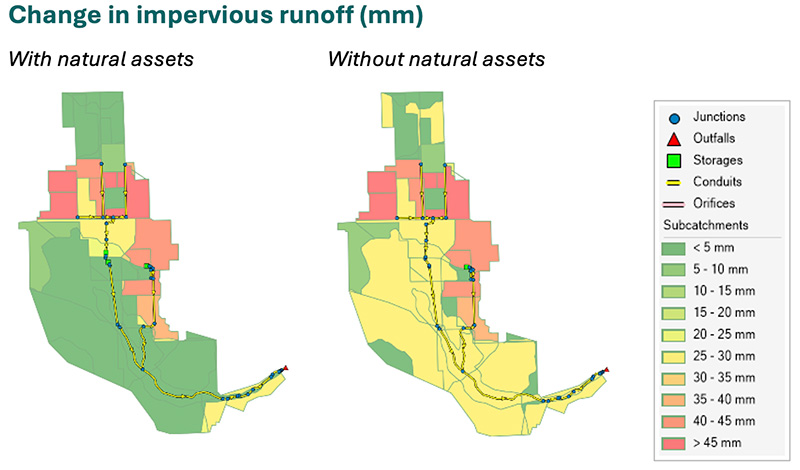Natural Assets for Stormwater Mitigation
Photo credit: Jennifer C.Fun on the Sunshine Coast Trails, Taken on September 15, 2018
Project Details
Location: |
British Columbia, Canada, 54.82861, -125.18094 & Nova Scotia, Canada, 45.06034, -63.72310 | |
Client: |
Natural Assets Initiative | |
Duration: |
November 2020 – June 2024 | |
Team Member(s): |
Cedar Morton, Frank Poulsen, Curtis Quirion, Aaron Tamminga | |
Practice Area(s): |
Nature Based Solutions | |
Services Employed: |
Ecological modelling, GIS analysis, Natural asset inventory, Natural asset planning and decision support, Economic assessment, Science communication |
The Problem We Aimed to Solve
Municipalities across Canada are confronted by aging infrastructure for key services like terrestrial stormwater mitigation. This infrastructure is costly to replace, but natural assets like forests can sometimes be used to provide the same levels of service at less cost while simultaneously contributing a range of co-benefits, like recreation opportunities, that engineered assets do not deliver. The Natural Assets Initiative (NAI) is working with local governments to develop natural asset inventories and preliminary economic valuations of available natural asset management options. During two separate projects, the Town of Gibsons in BC and the Halifax Regional Municipality in Nova Scotia wanted to understand their natural asset inventories and the value of ecosystem services for stormwater mitigation and other co-benefits from forests and wetlands/peatlands.
How We Helped
In Gibsons, we worked with the Town to identify forest and wetland assets of interest and to develop condition and risk scores for those assets using a combination of spatial data and input from local experts. We displayed these in an interactive web-based dashboard. Once the asset inventory was complete we evaluated baseline levels of service and worked with the Town to develop alternative management scenarios involving different treatments applied to those assets. We then modeled the stormwater function of the assets under multiple management alternatives using the PCSWMM model system, comparing results to baseline levels of service. In addition to PCSWMM modelling, we completed an economic valuation of various co-benefits provided by the forest and wetland assets using benefit transfer, supported development of operations and maintenance costing, and examined how terrestrial stormwater modelling can be coupled with other modelling for coastal storms in an integrated Source-to-Sea natural asset management system.
In the Halifax Regional Municipality, we completed a similar case study of the Nine-mile Watershed near Timberlea, NS, this time focused only on modelling baseline stormwater mitigation services by forests and peatlands with PCSWMM, then completing economic valuation of those services and various co-benefits, including human health benefits.
Our Project’s Impacts
Our interactive web-based spatial inventories classify and display natural assets. We also complete condition/risk assessments across multiple indicators. These tools are a standard part of ESSA’s nature-based solutions service package. The inventories are an essential first step for clients interested in building natural assets into their asset planning and accounting. They also aid in determining baseline levels of service. During these two projects, we evaluated baseline levels of service from forests and wetlands/peatlands for stormwater mitigation, and in the case of Gibsons, BC, we simulated how these levels of service would change under alternative futures that included changes to forest management, wetland restoration, riparian areas management, restoration of stream geomorphology, and future climate change. We evaluated these scenarios using change in streamflow relative to the baseline, as well as the difference in cost of restoring stream flows with stormwater retention ponds with/without the assets. A key outcome in Gibsons, for example, was that while forests in Gibsons provide most of the benefit overall, wetlands are more beneficial per hectare. Gibsons and the Halifax Regional Municipality now have the valuation information they need to support conservation and maintenance of forest and wetland/peatland assets in the two study areas.


